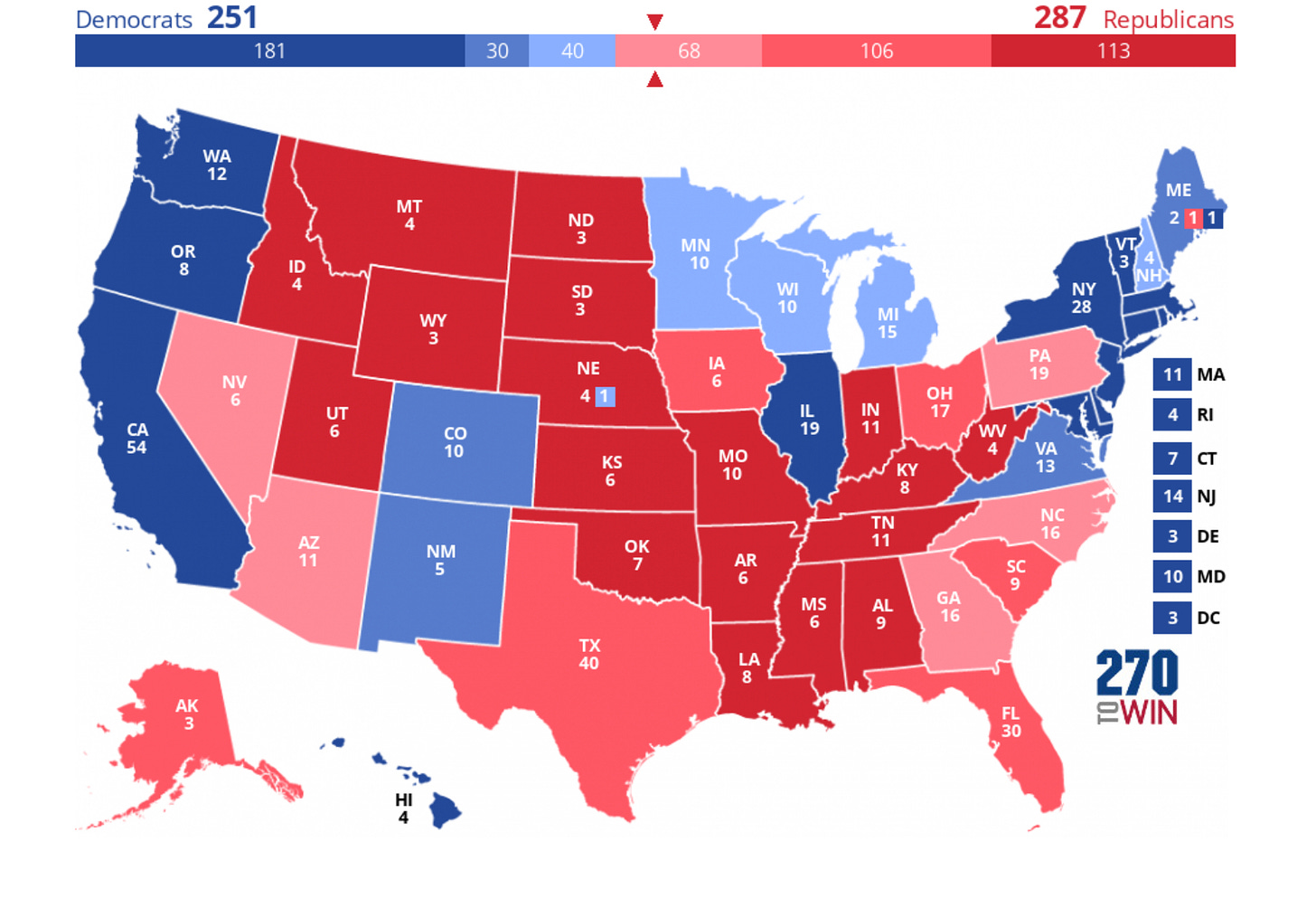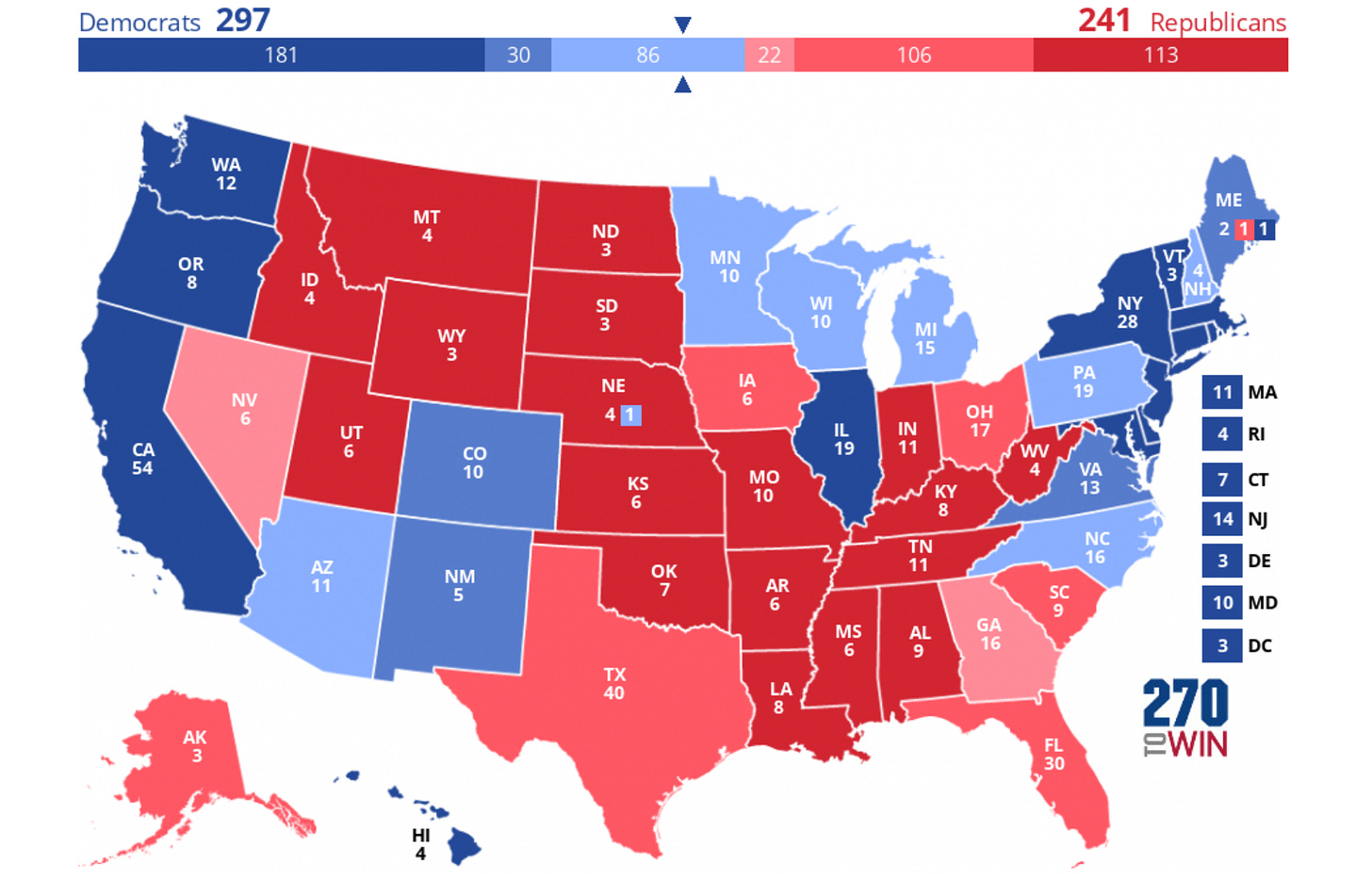As I’ve pointed out in the past, your vote for president doesn’t really matter unless you live in a swing state. The Electoral College system means that if your state is reliably blue or red, your vote is simply added to the winner’s margin in your state. It won’t help your candidate win elsewhere.
Also called “battleground states, the swing states “swing” from one party to the other and provide a tipping point in the election as they grant one of the candidates 270 electoral votes and a majority of the Electoral College. The swing states are where it’s at and if you are interested in the outcome of the election, they are what you should be paying attention to rather than the national “horserace” polls.

Swing states shift over time. Just a few years ago, Colorado, Florida, and Ohio were swing states. These days, Colorado is reliably blue while Florida and Ohio go red.
Having said that, the swing states from 2020 are still the swing states in 2024. Those states are typically considered to be Arizona, Georgia, Michigan, North Carolina, Nevada, Pennsylvania, and Wisconsin. These are the states where the presidential election will be decided. These are the states that are left blank on the 270towin electoral maps.
Let’s take a closer look.
Arizona is a mess. The state was very close in 2020 and was embroiled in claims of election fraud by both Donald Trump and gubernatorial candidate Kari Lake. The Arizona Police Association just endorsed the Democratic senatorial candidate over Kari Lake, who, like Trump, is back again for another try. Biden won Arizona in 2020 and was the first Democrat to do so in a presidential election since 1996.
In terms of polling, Arizona has tightened considerably in the Real Clear Polling average since Biden’s withdrawal in July. Biden trailed by about six points, and Trump continues to hold a margin-of-error half-point lead in the average. It’s too close to call.
My home state of Georgia is a new swing state. Before 2020, the last Democrat to win the Peach State was Bill Clinton in 1992. Joe Biden benefitted from Stacey Abrams’ grassroots get-out-the-vote effort as well as Donald Trump’s ineffectual campaigning. In recent weeks, Trump has hurt his campaign in Georgia by picking fights with the state’s popular governor, Brian Kemp.
Currently, the RCP average shows Trump with a one-point lead, down from four when Biden withdrew. A caveat is that only one poll has been conducted in August. That NY Times/Siena poll showed Trump ahead by four points, but three other polls showed a tied race and one had Kamala Harris up by one point. It’s another tossup.
Michigan was blue from 1988 until 2016 and went back to the Democrats in 2020. Another state where Donald Trump contested election results, the current polling average shows Kamala Harris ahead by two points.
Nevada is a perennially close state, but one that has consistently gone Democrat for the past four presidential elections. This year, Trump currently holds his largest battleground lead here at 1.4 points above Harris in the polling average. Nevada may be a state where Trump’s plan for eliminating taxes on tips can make the difference thanks to the large service sector.
North Carolina is a state that I don’t really consider a swing state because it isn’t very swingy these days. It’s always close but the only time it has gone Democrat in recent years was for Barack Obama in 2008. Beyond that, you have to go all the way back to Jimmy Carter in 1976. North Carolina is tantalizingly close for Democrats but always just out of grasp.
Currently, the polling average has Trump ahead by less than a point after holding a commanding lead over Joe Biden. Harris led in the two most recent polls, but Trump still benefits in the average from his larger lead in older polls.
In Pennsylvania, Harris has also closed the gap from a five-point deficit under Biden to a very narrow Trump lead in the average today. Trump won Pennsylvania in 2016, the first Republican to do so since the first George Bush in 1988. Pennsylvania’s governor, Josh Shapiro was reportedly a contender to be Harris’s running mate, which could have helped Harris over the top.
Currently, Pennsylvania’s polling average shows a 0.2 percent lead for Donald Trump. This is about as close as it can get. It’s a statistical tie and almost a literal tie.
Wisconsin is the final current swing state and has also been reliably blue except for 2016. Wisconsin was the state with the highest polling error in 2016 when it was forecast to go comfortably for Hillary Clinton. Those problems were not completely resolved in 2020 when Biden won the state by less than a point, considerably less than the almost seven points in the RCP average. FiveThirtyEight, the other big polling aggregator, showed Biden with an even greater lead.
In 2024, RCP shows another close race with Harris leading by one point. This is still a tossup, and if Wisconsin polling is as flawed as previous years, the state could easily go for Trump.
It’s still a long time until Election Day and a lot can change. It’s also true that polls are not predictive. They are historical snapshots. Polls are most useful for identifying trends, and the current trend is that Kamala Harris has closed the gap with Trump everywhere but by varying degrees.
Let’s plug these results into the electoral map to see how the election might turn out if it were held today while understanding that the situation will almost certainly be different by November.
Using the results from the RCP averages, Trump would win Arizona, Georgia, North Carolina, Nevada, and Pennsylvania while Harris would win Michigan and Wisconsin. In this scenario, Trump would win the Electoral College by 287-251 and be returned to the White House.
But consider that many states are within one point and trending towards Harris. If we reset the map and allot these within-a-point states to Harris, the outcome is worse for Trump. Harris wins Arizona, Michigan, North Carolina, Pennsylvania, and Wisconsin. Trump would still win Georgia and Nevada. In this worse-case (but still not worst) scenario, Harris would win the Electoral College 297-241.
This exercise illustrates how close and how fluid the race currently is. A small change of less than a percentage point can result in a large swing in the Electoral College result. The most likely current outcome is probably somewhere between the scenarios.
And that’s not accounting for the possibility of new battlegrounds. For instance, Florida has become reliably red, but polling there has narrowed from a 10-point Trump lead to three points. This is within the margin of error, but it may be an outlier. If future polling shows similar close results, the Sunshine State may move back into the tossup column. At the very least, Trump will be likely to have to divert resources from other states to shore up Florida support.
The challenge for Trump is to stem the rising tide of Harris partisanship. This will require discipline that Trump has heretofore not shown on the campaign trail. The prospect of losing yet again may focus Mr. Trump’s mind and enhance his ability to follow the advice of his campaign staff, but in the past, The Former Guy has not been able to play it straight and serious for more than a week or two at a time. He can’t not be weird.
It will also require money to turn the race around. Biden had a cash advantage over Trump until The Debate From Hell. Since she entered the race, Harris has regained an advantage over Trump in both cash on hand and new donations. This financial advantage will make it more difficult for the Trump campaign to press its case against Harris should Trump ever decide to stop being distracted from the issues by the emotional need to make personal attacks.
It’s a tossup race, but Kamala Harris has the initiative and the edge. Watch this space for updates.
And remember, just because your vote for president doesn’t matter, it doesn’t mean that you shouldn’t vote. Turn out for those down-ballot races and pull the lever for the most conservative candidate who will hold Trump accountable.
ON AN ANECDOTAL NOTE I’ve noticed a lot more open support for Harris this year than I did for Biden in 2020 in my red county. This includes some signs, which haven’t been available for long, as well as outspokenness from people in community social media groups online. I’d be the first to caution that this sort of anecdote shouldn’t replace polling data and other objective measures, but there is definitely a different vibe than there was just a few months ago. And there is an old joke that the plural of “anecdote” is “data.”
I can speculate that
Take that information and do with it what you will.
RFKJR BYE-KU: Those who have followed for a while may remember that I have picked up James Taranto’s tradition of penning a haiku in memorial of candidates who drop out of the race. We recently lost RFKJR, who is now, along with Tulsi Gabbard, joining the Trump presidential transition team.
Noble family
Brain worms and park bears, oh my!
Needs many vaccines


No comments:
Post a Comment